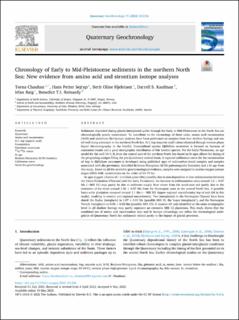| dc.contributor.author | Chauhan, Teena | |
| dc.contributor.author | Sejrup, Hans Petter | |
| dc.contributor.author | Hjelstuen, Berit Oline Blihovde | |
| dc.contributor.author | Kaufman, Darrell S. | |
| dc.contributor.author | Baig, Irfan | |
| dc.contributor.author | Reinardy, Benedict T.I. | |
| dc.date.accessioned | 2023-02-27T12:00:40Z | |
| dc.date.available | 2023-02-27T12:00:40Z | |
| dc.date.created | 2022-09-09T08:37:23Z | |
| dc.date.issued | 2022 | |
| dc.identifier.issn | 1871-1014 | |
| dc.identifier.uri | https://hdl.handle.net/11250/3054205 | |
| dc.description.abstract | Sediments deposited during glacial-interglacial cycles through the Early to Mid-Pleistocene in the North Sea are chronologically poorly constrained. To contribute to the chronology of these units, amino acid racemization (AAR) and strontium (Sr) isotope analyses have been performed on samples from four shallow borings and one oil well along a transect in the northern North Sea. D/L Asp (aspartic acid) values obtained through reverse-phase liquid chromatography in the benthic foraminiferal species Elphidium excavatum is focused on because of consistent results and a good stratigraphic distribution of this benthic species. For the Early Pleistocene, an age model for the well 16/1–8, from the central part of the northern North Sea based on Sr ages allows for dating of the prograding wedges filling the pre-Quaternary central basin. A regional calibration curve for the racemization of Asp in Elphidium excavatum is developed using published ages of radiocarbon-dated samples and samples associated with the previously identified Bruhnes/Matuyama (B/M) paleomagnetic boundary and a Sr age from this study. Based on all the available geochronological evidence, samples were assigned to marine oxygen isotope stages (MIS) with uncertainties on the order of 10–70 ka.
Sr ages suggest a hiatus of <2 million years (Ma) possibly due to non-deposition or low sedimentation between the Utsira Formation (Pliocene) and the Early Pleistocene. An increase in sedimentation rates around 1.5 ± 0.07 Ma (∼MIS 51) may partly be due to sediment supply from rivers from the south-east and partly due to the extension of ice sheet around 1.36 ± 0.07 Ma from the Norwegian coast to the central North Sea. A possible basin-wide glaciation occurred around 1.1 Ma (∼ MIS 32) (upper regional unconformity/top of unit Q4 in this study), resulting in erosion and regional unconformity. Two interglacials in the Norwegian Channel have been dated: the Radøy Interglacial to 1.07 ± 0.01 Ma (possibly MIS 31, the ‘super interglacial’), and the Norwegian Trench Interglacial to 0.50 ± 0.02 Ma (possibly MIS 13). A massive till unit identified at the same stratigraphic level in all shallow borings may partly represent an extensive MIS 12 glaciation. This study shows that the combined use of amino acid racemization data and Sr isotope chronology can refine the chronological ambiguities of Quaternary North Sea sediments related partly to the impact of glacial processes. | en_US |
| dc.language.iso | eng | en_US |
| dc.publisher | Elsevier | en_US |
| dc.rights | Navngivelse 4.0 Internasjonal | * |
| dc.rights.uri | http://creativecommons.org/licenses/by/4.0/deed.no | * |
| dc.title | Chronology of Early to Mid-Pleistocene sediments in the northern North Sea: New evidence from amino acid and strontium isotope analyses | en_US |
| dc.type | Journal article | en_US |
| dc.type | Peer reviewed | en_US |
| dc.description.version | publishedVersion | en_US |
| dc.rights.holder | Copyright 2022 The Author(s) | en_US |
| dc.source.articlenumber | 101336 | en_US |
| cristin.ispublished | true | |
| cristin.fulltext | original | |
| cristin.qualitycode | 1 | |
| dc.identifier.doi | 10.1016/j.quageo.2022.101336 | |
| dc.identifier.cristin | 2050111 | |
| dc.source.journal | Quaternary Geochronology | en_US |
| dc.identifier.citation | Quaternary Geochronology. 2022, 71, 101336. | en_US |
| dc.source.volume | 71 | en_US |

